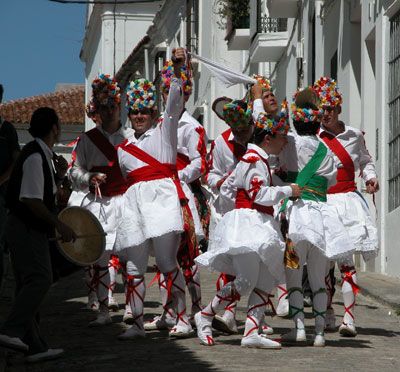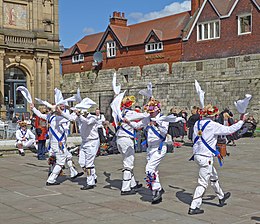Moorish dancing in Fuentes de León
- Peter Barron

- Jun 17, 2020
- 3 min read
Updated: Oct 14, 2020
This week should have been Corpus Christi, the biggest date in Fuentes de León's packed fiesta calendar. But this year, because of coronavirus, the processions and parties couldn't happen. On social media, the most lamented part of the week-long bash was Dia del Tambor, day of the drum, when the village's traditional dance troupe sashay around its streets with carnations in their mouths.

This passionately-held tradition—said to date from the time of Emperor Carlos V—is commemorated in mosaic on the cobbles of a street named Calle Danzantes. This is southern Spain, but the steps and costumes are nothing like flamenco. In fact they look English, a lot like Morris dancing.
We first noticed this phenomenon in the nearby town of Fregenal de la Sierra when we went to the International Festival of the Mountains, held there every August. On stage when we arrived were a troupe of dancers performing what looked exactly like something you'd see on Plough Monday in an English village pub carpark.
It was a group of men in white shirts and floral hats, bells on stockings, handkerchiefs held between their fingers, lifting their knees and interweaving to the strains of a pipe and drum. We assumed they were festival guests from an English hilltop community (there were several groups of brightly dressed international mountain folk waiting in the wings), but when we checked the programme we were astonished to see that they were from Extremadura.
What on earth was this peculiarly English tradition doing here?
Fregenal de la Sierra (photo: turismofregenal) York (photo: Tim Green)
Morris dancing has never been something I've taken much of an interest in, but the most basic research—a visit to the extensive Wikipedia page—suggests it first came to England from Spain in the 15th century. The word Morris almost certainly comes from Moorish, after the North Africans who occupied southern Spain for hundreds of years until their final defeat and expulsion in 1492.
The earliest written mention in English dates from 1448 when records show the payment of seven shillings to Morris dancers from London's Goldsmiths' Company. "Spangled Spanish dancers" performed an energetic dance for Henry VII at Christmas in 1494. If you go to the small folk museum inside Fregenal's castle, and you should, you'll see a mannequin of a traditional dancer in spangled hat and white tunic, sashed in red. The dancers here celebrate the festival of Our Lady of Good Health, but its roots are clearly Islamic.
Last year, a friend of ours with a house in Fuentes de León invited us to watch the Corpus Christi procession from her balcony, and to scatter rose petals on the religious pasos as they went by.
Here's a video of the danzantes, accompanied by the celebrated drummer and piper Félix de Carboneras. Look at his instruments and the dancers' hats and bells, and compare with this woodcut from 1600, of the Shakespearean actor William Kempe Morris dancing his way from London to Norwich. Spooky.
Photo: Adolfobrigido / CC BY-SA
And check out this statue in the Munich Stadtmuseum of a North African morisketänzer from 1480, which may help explain the controversial practice of some English Morris dancers who still insist on performing in blacked up faces. As traditionally English as they appear, they are harking back to a dance from medieval Moorish Spain. That same dance, music and costume continue in Fuentes de León today, almost completely unchanged. Well, not today, but they will continue, next year.

Photo: Shakko










Hi Peter,
I read with interest your article on TNE (12/05/22) about the Morris dancing tradition and its Spanish origins. This is a well observed and researched point, which I also knew about through the writings of José María Blanco White, a Spanish heterodox writer and thinker from Seville who was part of the Spanish Liberal Exile in England at the beginning of the 19c. BW published very similar observations about the origins of Morris dancing in his Cartas de Inglaterra (Carta VII) which, interestingly, were also published in the form of regular articles, from 1823-1825, in the newspaper Variedades o Mensagero de Londres.
Thank you for such an enjoyable reading, which brought back memories of my sunny pueblo in…